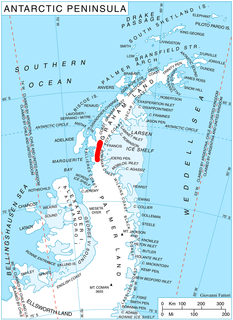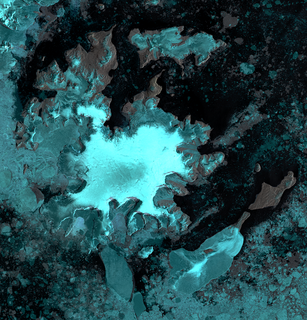
James Ross Island is a large island off the southeast side and near the northeastern extremity of the Antarctic Peninsula, from which it is separated by Prince Gustav Channel. Rising to 1,630 metres (5,350 ft), it is irregularly shaped and extends 64 km in a north–south direction. It was charted in October 1903 by the Swedish Antarctic Expedition under Otto Nordenskiöld, who named it for Sir James Clark Ross, the leader of a British expedition to this area in 1842 that discovered and roughly charted a number of points along the eastern side of the island. The style, "James" Ross Island is used to avoid confusion with the more widely known Ross Island in McMurdo Sound.

Shaler Cliffs is a rock cliffs 2 miles (3.2 km) east-southeast of Charpentier Pyramid, rising to 1,000 m in the north part of Herbert Mountains, Shackleton Range. Photographed from the air by the U.S. Navy, 1967, and surveyed by British Antarctic Survey (BAS), 1968-71. In association with the names of glacial geologists grouped in this area, named by the United Kingdom Antarctic Place-Names Committee (UK-APC) after Nathaniel S. Shaler (1841-1906), American geologist, joint author with geographer William Morris Davis of Glaciers and of papers on glacial geology, 1884-92.

El-Sayed Glacier is a glacier about 15 nautical miles long which drains the northeast slopes of Zuncich Hill in Marie Byrd Land. It flows northeast to enter Land Glacier at the south side of Mount Shirley. It was mapped by the United States Geological Survey from surveys and U.S. Navy air photos, 1959–65, and was named by the Advisory Committee on Antarctic Names for Sayed Z. El-Sayed, a United States Antarctic Research Program oceanographer on the International Weddell Sea Oceanographic Expeditions, 1967–68 and 1969–70.

Ahlmann Glacier is the southernmost of two glaciers on the east side of Hemimont Plateau flowing east into Seligman Inlet on Bowman Coast, Graham Land in Antarctica. The glacier was photographed from the air in 1940 by the United States Antarctic Service, and was charted in 1947 by the Falkland Islands Dependencies Survey, who named it for Professor Hans Wilhelmsson Ahlmann, a Swedish glaciologist and geographer.

Alberts Glacier is a heavily crevassed glacier in Antarctica. It is about 8 miles (13 km) long, and flows east from Avery Plateau, Graham Land, until entering Mill Inlet between Balch Glacier and Southard Promontory. The glacier was photographed from the air by the U.S. Navy in 1968. It was delineated from these photographs by Directorate of Overseas Surveys, 1980, and positioned from surveys by Falkland Islands Dependencies Survey, 1947–57. In association with the names of Antarctic historians around the area, it was named by United Kingdom Antarctic Place-Names Committee after Fred G. Alberts, an American toponymist, and secretary of the Advisory Committee on Antarctic Names 1949–80.
Jamieson Ridge is a narrow ridge 1 nautical mile (2 km) long, rising to about 1,200 metres (4,000 ft) at the southwestern end of the Herbert Mountains, in the Shackleton Range, Antarctica. It was photographed from the air by the U.S. Navy, 1967, and surveyed by the British Antarctic Survey, 1968–71. In association with the names of glacial geologists grouped in this area, it was named by the UK Antarctic Place-Names Committee in 1971 after Thomas F. Jamieson, a Scottish geologist whose work on the ice-worn rocks of Scotland developed the true origin of glacial striae in 1862, and who in 1865 originated the theory of isostasy.
Kuven Hill is a prominent hill between Gommen Valley and Kuvsletta Flat, near the southwest end of the Kirwan Escarpment in Queen Maud Land, Antarctica. It was mapped by Norwegian cartographers from surveys and air photos by the Norwegian–British–Swedish Antarctic Expedition (1949–52) and additional air photos (1958–59), and named Kuven.

Frankenfield Glacier is a small glacier in the northeast part of Noville Peninsula, Thurston Island, in Antarctica. It flows east-northeast to the Bellingshausen Sea between Mount Feury and Mulroy Island. The glacier was first roughly delineated from air photos taken by U.S. Navy Operation Highjump in December 1946, and was named by the Advisory Committee on Antarctic Names for Lieutenant Chester Frankenfield, a meteorologist on the U.S. Navy Bellingshausen Sea Expedition, who established an automated weather station on Thurston Island in February 1960.
Geikie Nunatak is a nunatak 3 nautical miles (6 km) west of Mount Absalom in the southwestern end of the Herbert Mountains of the Shackleton Range, Antarctica. It was photographed from the air by the U.S. Navy in 1967, and surveyed by the British Antarctic Survey, 1968–71. In association with the names of glacial geologists grouped in this area, it was named by the UK Antarctic Place-Names Committee in 1971 after James Geikie, Professor of Geology at the University of Edinburgh from 1882, who was one of the first to recognize that multiple glaciations occurred during the Pleistocene period.

Gourdon Glacier is a glacier 4 nautical miles (7 km) long on the east side of James Ross Island, flowing southeast into Markham Bay between Saint Rita Point and Rabot Point. It has a conspicuous rock wall at its head. The glacier was first surveyed by the Swedish Antarctic Expedition under Otto Nordenskiöld, 1901–04, who named it for Ernest Gourdon, geologist and glaciologist of the French Antarctic Expedition, 1903–05.
Green Glacier is a glacier on the east side of Graham Land, Antarctica, 15 nautical miles (28 km) long and 4 nautical miles (7 km) wide, flowing from the plateau northeast between Dugerjav Peak and Rugate Ridge, and then east into Vaughan Inlet next north of Pirne Peak and south of the terminus of Hektoria Glacier.

Marze Peak is a rock peak with twin summits near the south end of the ridge between Wessbecher Glacier and Hudman Glacier, in the Petvar Heights at the south end of the Sentinel Range, Ellsworth Mountains, Antarctica. It was mapped by the United States Geological Survey from surveys and U.S. Navy air photos from 1957–59, and was named by the Advisory Committee on Antarctic Names for Marion O. Marze, an aviation machinist's mate from the U.S. Navy who perished in the crash of a P2V Neptune airplane at McMurdo Sound on October 18, 1956.
Hushen Glacier is a glacier lying at the southwestern part of the base of the Mendelssohn Inlet, an inlet lying between Derocher Peninsula and Eroica Peninsula indenting the north face of Beethoven Peninsula, in the southwestern portion of Alexander Island, Antarctica. The glacier flows northeast while joining Reuning Glacier which discharges into the south part of Mendelssohn Inlet. It was mapped by the United States Geological Survey from U.S. Navy aerial photographs taken 1967–68 and from Landsat imagery taken 1972–73, and was named by the Advisory Committee on Antarctic Names for W. Timothy Hushen, Director of the Polar Research Board at the National Academy of Sciences, 1981–88.
Maclaren Monolith is a peak rising to about 1,000 metres (3,300 ft) on the central ridge of the Herbert Mountains, Shackleton Range, Antarctica. The feature is notable for a monolith forming the summit. It was photographed from the air by the U.S. Navy in 1967, and surveyed by the British Antarctic Survey between 1968–71. In association with the names of glacial geologists grouped in this area, it was named by the UK Antarctic Place-Names Committee in 1971 after Charles Maclaren, a Scottish naturalist who in 1842 was the first to recognize the glacial control of sea level.
The Hollingworth Cliffs are a line of cliffs to the south of Mount Absalom in the Herbert Mountains of the Shackleton Range in Antarctica. They were photographed from the air by the U.S. Navy in 1967, and surveyed by the British Antarctic Survey, 1968–71. In association with the names of glacial geologists grouped in this area, they were named by the UK Antarctic Place-Names Committee after Sydney E. Hollingworth, a British geologist who specialized in the Pleistocene geology of northwest England, and was Professor of Geology at University College London, 1946–66.

Hotine Glacier is a glacier 10 nautical miles (19 km) long which is divided at its mouth by Mount Cloos, flowing west into both Deloncle Bay and Girard Bay on Kiev Peninsula, on the west coast of Graham Land, Antarctica. It was first charted by the Belgian Antarctic Expedition under Gerlache, 1897–99, and was named by the UK Antarctic Place-Names Committee in 1959 for Brigadier Martin Hotine, Director of Overseas Surveys.

Ramsay Wedge is a narrow rock spur, 2 nautical miles (3.7 km) long, with talus slopes rising to about 1,200 m, located 2 nautical miles (3.7 km) southwest of Mount Absalom in the southwest portion of the Herbert Mountains, Shackleton Range. Photographed from the air by the U.S. Navy, 1967, and surveyed by British Antarctic Survey (BAS), 1968-71. In association with the names of glacial geologists grouped in this area, named by the United Kingdom Antarctic Place-Names Committee (UK-APC) after Sir Andrew C. Ramsay (1814–91), Scottish geologist who first recognized the glacial origin of rock basins in 1862; Director-General, Geological Survey of Great Britain, 1871-81.
Kendall Basin is an ice-free cirque at the northwest end of the Herbert Mountains, in the Shackleton Range, Antarctica. It was photographed from the air by the U.S. Navy, 1967, and surveyed by the British Antarctic Survey, 1968–71. In association with the names of glacial geologists grouped in this area, it was named by the UK Antarctic Place-Names Committee in 1971 after Percy Fry Kendall, an English glacial geologist, Professor of Geology at Leeds University in the early 20th century.











